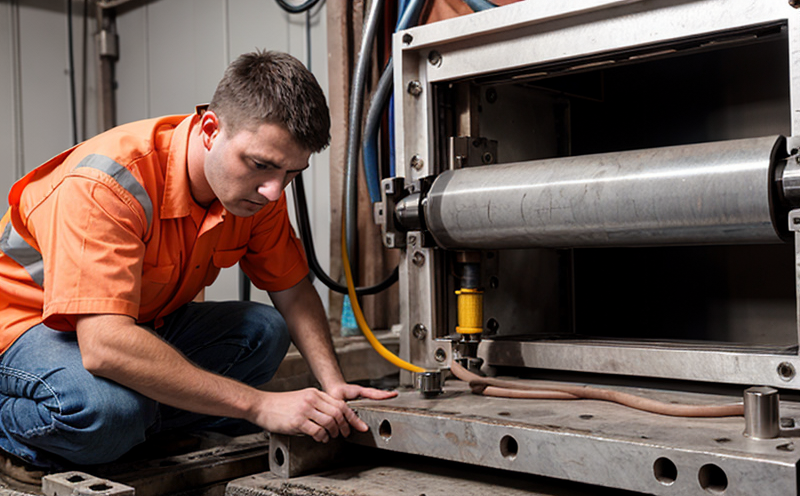IEC 62262 IK Rating Mechanical Impact Testing for Lighting Enclosures
The International Electrotechnical Commission (IEC) standard IEC 62262 specifies the mechanical impact testing procedure to determine the resistance of lighting enclosures against mechanical impacts. This test is crucial in ensuring that luminaires and their associated components meet stringent safety requirements, particularly when exposed to environmental or accidental mechanical stresses.
The IK rating system evaluates the impact resistance of electrical equipment by subjecting specimens to predetermined levels of mechanical stress using standardized impact devices. The IK rating consists of a number followed by K (e.g., IK09), which indicates the energy level in joules that the specimen can withstand without compromising its safety integrity.
During this testing procedure, the lighting enclosure is subjected to repeated impacts from an impact hammer or similar device. The hammer strikes the specimen at specific locations and angles defined by the standard. The force applied corresponds to different levels of potential mechanical stress encountered in real-world scenarios, such as vehicular collisions, pedestrian accidents, or rough handling during installation.
Following each impact, detailed observations are made to assess any visible damage to the enclosure or its contents. Acceptance criteria dictate that no hazardous conditions should arise due to the testing process—such as electrical shorts, structural failures, or breaches in insulation—that could pose a risk to users. Compliance with these stringent requirements ensures that lighting fixtures remain safe and reliable even under extreme mechanical stress.
Our laboratory adheres strictly to all relevant IEC standards when performing this type of mechanical impact testing. Our state-of-the-art facilities feature purpose-built chambers designed to simulate various environmental conditions, including temperature variations, humidity exposure, and dust accumulation. This comprehensive approach guarantees accurate results that are both consistent with industry best practices and compliant with regulatory requirements.
The benefits of undergoing IEC 62262 IK Rating Mechanical Impact Testing extend beyond mere compliance; they also contribute significantly to product development efforts by providing valuable insights into how different designs perform under stress. By identifying potential weaknesses early in the design phase, manufacturers can make necessary modifications before full-scale production begins—thereby reducing costs associated with rework or recalls later on.
For R&D engineers tasked with innovating new products, this testing process offers critical feedback regarding material selection and structural design choices. Real-world data collected during these tests helps inform future iterations of product designs, ensuring they are not only safe but also robust enough to withstand typical operational conditions.
Scope and Methodology
The scope of IEC 62262 IK Rating Mechanical Impact Testing encompasses the evaluation of lighting enclosures’ ability to resist mechanical impacts from various sources. This includes testing for resistance against dropped objects, vehicular collisions, pedestrian accidents, and other forms of accidental or environmental stress.
- Detailed specifications regarding specimen preparation
- Predefined locations on the enclosure where impact tests must be conducted
- A specified range of energy levels (in joules) used to simulate different types of mechanical stresses
- Standardized procedures for measuring and recording impacts
- Criteria for determining whether a specimen has passed or failed based on observed damage after testing
The methodology involves placing the lighting enclosure in a controlled environment that mimics real-world conditions as closely as possible. Once prepared, the specimen is subjected to repeated mechanical impacts using an impact hammer or similar device. Each strike is recorded for later analysis.
After completing all required tests according to the specified procedure, our team carefully inspects each specimen for any signs of damage that could compromise its safety. Any deviations from acceptable levels of integrity are documented thoroughly and reported back to clients.
Benefits
By ensuring compliance with IEC 62262 IK Rating Mechanical Impact Testing, manufacturers gain several advantages:
- Enhanced Safety: Products designed and tested according to these standards are less likely to fail under mechanical stress, thereby reducing risks associated with electrical equipment failures.
- Risk Mitigation: Early identification of potential weaknesses allows for timely corrective actions, minimizing the likelihood of costly product recalls or legal disputes.
- Precise Design Validation: Real-world data collected during testing provides valuable feedback on design choices, helping engineers refine future iterations of products.
- Regulatory Compliance: Ensuring adherence to international standards enhances market access and builds trust among consumers who value safety above all else.
In addition to these tangible benefits, this testing process fosters innovation by encouraging continuous improvement in product design and manufacturing processes. Through rigorous evaluation of materials and structures, manufacturers can identify areas for enhancement that ultimately lead to more reliable and safer lighting solutions.





